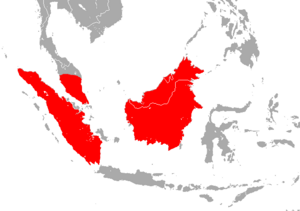Borneo roundleaf bat facts for kids
Quick facts for kids Borneo roundleaf bat |
|
|---|---|
| Conservation status | |
| Scientific classification | |
| Genus: |
Hipposideros
|
| Species: |
doriae
|
 |
|
| Borneo roundleaf bat range | |
| Synonyms | |
|
|
The Borneo roundleaf bat is a small, fascinating creature. It's also known as the Bornean leaf-nosed bat. Its scientific name is Hipposideros doriae. This bat belongs to a family called Hipposideridae. You can find these bats living in places like Borneo, Sumatra, and Peninsular Malaysia.
Contents
Discovering the Borneo Roundleaf Bat
Scientists give every living thing a special name. This helps them organize and study nature. This is called taxonomy. The Borneo roundleaf bat was first described in 1871. A German scientist named Wilhelm Peters gave it its first scientific name. He called it Phyllorhina doriae. Later, scientists decided it belonged to a different group. Now, its scientific name is Hipposideros doriae. Another name, Hipposideros sabanus, is also used for this species.
What Does the Borneo Roundleaf Bat Look Like?
This bat is quite small. It has dark fur that helps it blend into its surroundings. One unique feature is its nose leaf. It doesn't have small folds on the sides. The back part of its nose leaf also lacks a special support structure. Its forearm, which is a key measurement for bats, is about 34 to 37 mm (or 1.3 to 1.5 inches) long.
Where Does This Bat Live?
The Borneo roundleaf bat lives in parts of Southeast Asia. You can find it in Malaysia, Borneo, and Sumatra. These bats prefer to live in primary forests. Primary forests are old, untouched forests. They are not known to live in areas where humans have changed the land. This means they need healthy, undisturbed forests to survive.
Helping the Borneo Roundleaf Bat
The Borneo roundleaf bat is currently listed as a near-threatened animal. This means it could become endangered if its situation doesn't improve. The biggest problem for these bats is losing their homes. Forests are being cut down for farming and plantations. Forest fires also destroy their habitat. However, there's good news too! These bats live in some protected areas. These special places help keep their homes safe.


